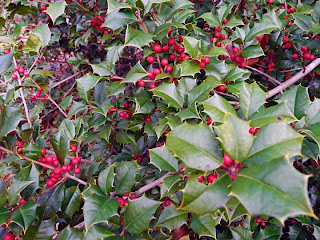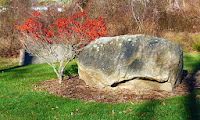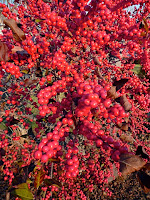by Toni Leland
I find it interesting that, as the winter months descend upon us, Mother Nature provides touches of red to brighten the barren landscape in many parts of the country. Here are some ideas to plant for brightening your own property next season.
 |
| American Holly (Ilex opaca) |
Holly, of course, is well-known. Many of the evergreen hollies (Ilex spp.) with the prickly leaves and bright red berries are grown as foundation plantings to provide visual relief during the winter. Even after the birds have eaten all the berries, the glossy green leaves remain. But have you looked at the deciduous hollies?
 |
| American Winterberry (Ilex verticillata) |
 |
| American Winterberry |
This yummy Ilex verticillata - also known as American Winterberry - has lovely leaves and growth habit to enhance any garden or property, but they shine best when the temperatures begin to drop and the berries form. The leaves disappear, making room for plump, glorious berries that look good enough to eat. And these shrub specimens can be seen from blocks away!
 |
| Burning Bush (Euonymus alata) |
Now, I know that many gardeners abhor Burning Bush (Euonymus alata) and sometimes with good reason: this imported shrub is invasive in many regions and I know, personally, that the shrub can overtake an area quickly if not controlled. But oh, look at this color in the late fall! And when the snow falls on the leafless shrubs, the tiny red berries look like jewels on cotton.
 Of course, these tiny red berries are very fertile and those left behind by the birds will each produce a tiny shrub in the spring. To maintain a Burning Bush for its beautiful foliage, yet prevent being overrun by babies, shearing the branches as the yellow flowers mature is an answer. Some of the dwarf cultivars are considered not so invasive.
Of course, these tiny red berries are very fertile and those left behind by the birds will each produce a tiny shrub in the spring. To maintain a Burning Bush for its beautiful foliage, yet prevent being overrun by babies, shearing the branches as the yellow flowers mature is an answer. Some of the dwarf cultivars are considered not so invasive.
So, when it's cold and gray outside, what can you use to brighten the inside of your home? Two brilliant red houseplants come to mind, and both arrive in November and usually last through January, if conditions are right.
The traditional "Amaryllis" bulb that appears in the stores
 |
| Hippeastrum 'Grand Cru' |
around Thanksgiving is actually a genus of South American bulbs known as Hippeastrum, which are always grown indoors. (The true Amaryllis is a southern Africa bulb and is usually grown outdoors.) Though these bulbs come in several colors, the reds are magnificent! And watching them emerge and grow is fascinating.
 |
| Poinsettia 'Jingle Bells' |
Another gorgeous red houseplant is the traditional Poinsettia, with bright little yellow flowers (or cyathia) and velvety bracts (modified leaves) that now come in amazing combinations and colors. But if you're looking for red, that is the natural coloring. This link to my in-depth article will give you even more information on the history, cultivars, and care of your Poinsettias.
Do you have a favorite red winter plant?
All images and content ©Toni Leland




 Of course, these tiny red berries are very fertile and those left behind by the birds will each produce a tiny shrub in the spring. To maintain a Burning Bush for its beautiful foliage, yet prevent being overrun by babies, shearing the branches as the yellow flowers mature is an answer. Some of the dwarf cultivars are considered not so invasive.
Of course, these tiny red berries are very fertile and those left behind by the birds will each produce a tiny shrub in the spring. To maintain a Burning Bush for its beautiful foliage, yet prevent being overrun by babies, shearing the branches as the yellow flowers mature is an answer. Some of the dwarf cultivars are considered not so invasive.


No comments:
Post a Comment